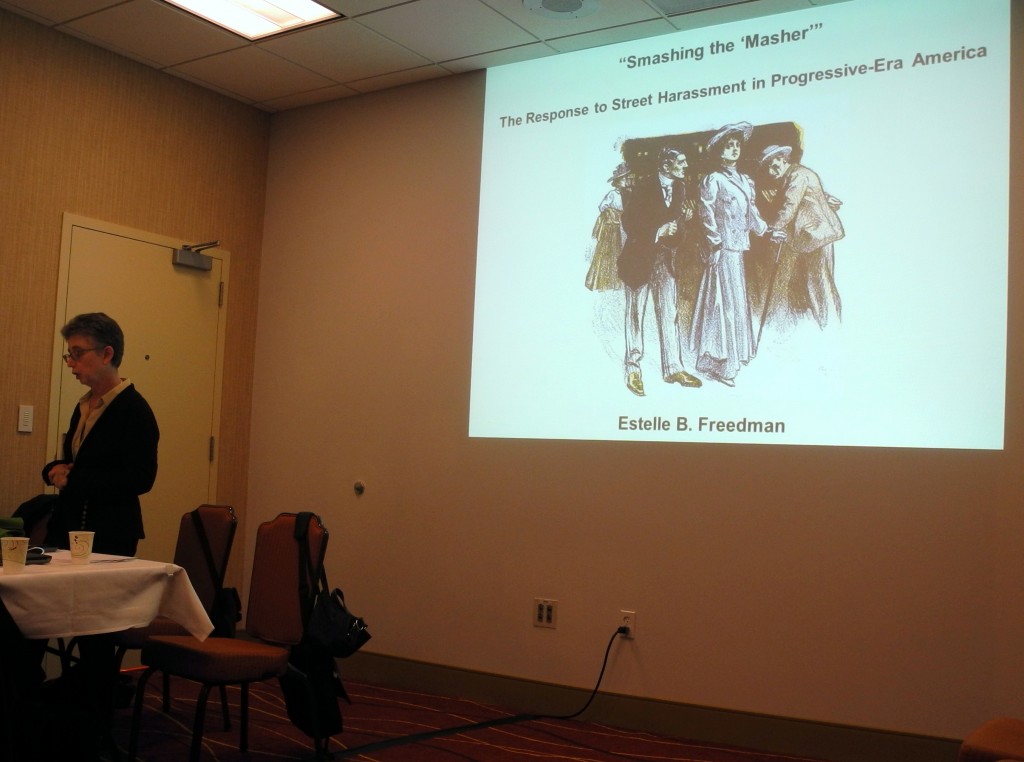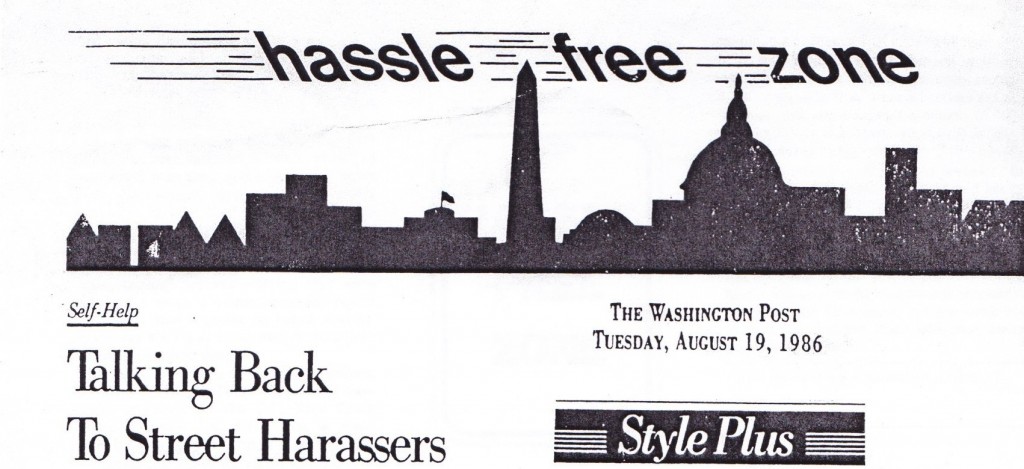“Want to take a ride, little girl?” ~ Street harasser from the early 1900s.
As more and more scholars are uncovering, street harassment is not a new social problem. Stanford University Professor Estelle Freedman is one of the latest people to explore this in a chapter of her new book Redefining Rape: Sexual Violence in the Era of Suffrage and Segregation (the major themes of the book and two lessons for today are covered in Part 1).
Street harassment predates this time period and poor women who have always been in public places for work have likely always faced street harassment (and worse), but once middle-class women began experiencing it in large numbers in the late 1800s and early 1900s, they made it a visible problem.
By the late 1800s and early 1900s, a growing number of people lived in cities instead of farms or small villages and many white men used the new anonymity a city afforded them to harass women without facing consequences. Around this time period, more middle-class women of all races were in public spaces unaccompanied by men as they went to work, shops, and the theater, and as “unescorted women,” some men saw them as “fair game.” Phrases used by street harassers sound the same as today: “Hey, baby,” “Hey, honey,” “How much for you?”
Upset by this unwanted attention, many middle class women — both white and black — spoke out and took action, making it visible in newspapers and other publications.
Dr. Freedman graciously spoke with me by phone to answer a few questions for this article and sent me a complimentary copy of the book to raffle off!
1. HK: While the chapter focuses mostly on street harassment in the early 1900s, you found references to it in the 1770s when women expressed their concerns about “sexual dangers” in public spaces and spoke about their desire to have the “liberty to travel freely.” Did you find it surprising that very similar language to what anti-street harassment activists use today to talk about equality in public spaces was used hundreds of years ago by women? Why or why not?
EF: I’m not entirely surprised. Women began to use the language of rights in different historical periods in different cultures. In England and the United States, at the time when women were moving into the public sphere in larger numbers it was also a time of democratic revolutions and women said, “We deserve our rights, too.”
While street harassment was probably going on consistently through the centuries, the condemnation of harassment strongly correlates with the height of the suffrage movement in the early 1900s — and in more recent decades, with the feminist movement — and other claims to space and rights.
2. HK: Throughout your chapter, you cite newspaper articles featuring women who verbally and physically fought back against street harassers and even reported them to the police using laws like disorderly conduct so that the harasser faced a fine or a night in jail. Do you have a favorite story among the many you read?
EF: Two stories come to mind right away. One is from 1924 in New York City when a black woman was riding the subway and a white man from a southern state is trying to pick her up as a prostitute. When she refused his attention, he told her that if they had been in Georgia, “I would have you strung up.” A white woman who witnessed this joined her and detained him until the police arrived and arrested him. This is a really rare example of a black and a white woman cooperating together and bringing in the authorities. It was very striking and atypical.
Another story I like is in Chicago around 1906-1908 when women held self defense classes in parks for other women. The idea was to help them feel less fearful in the streets, to walk with confidence, and to give them a sense of their physical power while in public spaces.
3. HK: After World War I, there was a shift in how street harassment was viewed by the public. For a few decades leading up to the war, street harassment was largely seen as inappropriate and women who fought back were applauded, but then there was a shift to where it was seen as flirting and something women asked for by being unaccompanied in public spaces. There was also a heightened concern for the men accused of being harassers. Can you talk a little bit more about why this shift happened and its legacy?
EF: The new sexual values at that time that acknowledged women’s sexual agency and that encouraged women to not accept that they were passive objects of men’s desires was double edged: in some ways it empowered young women to feel able to be active sexual agents but it also meant that the line between wanted and unwanted sexual attention could be blurred. Once flirting became seen as acceptable public behavior between young people in public places, it became easier for street harassers to say, “I wasn’t doing anything wrong. I was just flirting,” and that was taken as an acceptable response.
In the early 1900s, there were police women (mostly white) who went undercover and arrested men who harassed them. One of the reactions to this was the concern that men were being victimized by women who didn’t like men or by women who didn’t understand the new sexual mores. There was a growing belief that female police officers were arresting men for behaviors that should no longer be criminalized.
In short, the new morality just after WWI made it harder to always know when the line has been crossed between wanted and unwanted attention.
In the white press, there were still some stories about women who fight back and they were applauded for doing so, but after the 1910s, there were fewer stories supporting women’s self defense and more sympathetic stories about men fearing being false accused.
Many African Americans migrated north during this time period and in the black press, however, there was actually an increase in articles focused on white men harassing black women and girls, treating them like prostitutes. The black presses called out white men for this behavior and fought to establish black women’s respectability.
4. HK: Today, sometimes men of color are disproportionately blamed for street harassment and depicted as street harassers. I found it interesting, then, to learn that in the time period you examined, the majority of news stories and reports featured white men as harassers – of both white and African American women. Can you share why this was, and how it ties into the larger issues of race in your book?
EF: In the newspapers, early nineteenth century mashers were all white and for good reason. For a black man to even chance looking at white woman on the street could lead to lynching. They had much less opportunity to be harassers. It would have been highly dangerous. [The newspapers typically only depicted white men as harassers of black women, too. While black women faced street harassment by black men, they largely kept quiet for fear of fueling the myth that black men were sexual predators.]
By type casting white men as a masher, it reinforced the idea that white men are harassers and black men are rapists. Keeping white men in the role of minor offenders masked white men’s more sever offenses against white and black women.
5. HK: Right now, there is a huge resurgence in attention to the issue of street harassment and what we can do about it. What is one lesson you think we can learn today from how the issue was treated and addressed in the late 1800s to early 1900s?
EF: One lesson is that you can’t separate the issue of street harassment from the larger issue of inequality. Women are underrepresented in legislatures, leadership, and are underpaid, and as long as women occupy a subordinate position economically and politically, they’re going to remain more sexually vulnerable.
Whenever women are mobilizing politically to get more rights, they also seem to have more of a vocal voice opposing sexual violence and street harassment. We need to keep the vulnerability of sexual assault and street harassment within the larger grid of women needing more economic and political leadership. We can’t treat it as separate.
Just passing laws doesn’t make a difference; we have to have a cultural shift, too. It’s really those deeper cultural values that can undermine the legal changes. Keeping an eye on what’s happening in the larger culture around sexuality is important and the more that women gain economically and politically, the more they can gain sexually.
You can find other scholarly articles, books, and theses about street harassment in the Stop Street Harassment resources section.
DRAWING:
Dr. Freedman donated a copy of her book (value $35) for me to give away in a drawing! Because of the cost of shipping the heavy book internationally, I am limiting this to people with U.S. addresses.
There are two ways to enter your name into the random drawing, you can:
1. Tweet out an article or resource from the SSH blog and add @stopstharassmnt #Mashers to it.
2. Submit a street harassment story or street respect story to the blog (include an email address and note in the “other” field you want to be included in the drawing).
I will hold the drawing on October 18.



 My name is Surayya I. Diggs, I am a recent graduate of
My name is Surayya I. Diggs, I am a recent graduate of 

